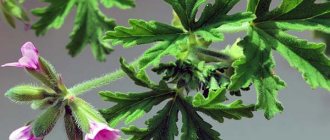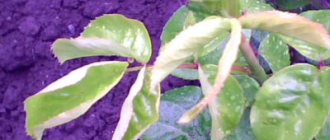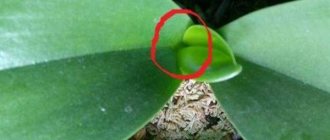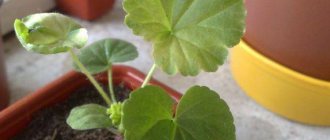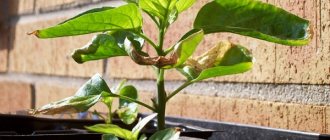In apartments and houses, bushes of exquisite flowering geraniums are often found on window sills. The plant is not considered rare, although some varieties are quite difficult to find. Pelargonium is easy to care for and does not require special conditions. Nevertheless, every gardener should know why geraniums do not grow in an apartment if the purchased bush was healthy and strong. It also happens that, having changed its habitat, it refuses to develop.
Why geraniums don’t grow: reasons
When planting a flowering plant on your windowsill, you should study its care preferences. Frequent reasons why geraniums do not grow are violations of agricultural practices.
Professionals reveal 4 secrets to successful cultivation:
- Regulated watering , which depends on the type of plant and the conditions under which it is kept. When watering pelargonium, you should remember that waterlogging the soil usually leads to the formation of rot. Most varieties prefer relatively dry soil. They are watered after the leaves droop slightly and show signs of wilting. In summer, the plant is watered every other day; in winter, the frequency is significantly reduced. Illiterate water procedures lead to the fact that the plant stops developing and stops growing. It is not recommended to spray geranium.
Growing on sunny windowsills (the optimal solution is placement on a south window) with direct sunlight. Light shading also suits her. But you shouldn’t place a flower pot away from windows. Shading causes the plant to shed its leaves, stop its development and freeze in the hope of becoming more active on sunny days.
- Temperature violation . If geranium grows poorly, what should you do - adjust the thermal regime for the plant? When growing crops, you should know that pelargonium prefers warmth in summer (22-26 degrees) and significant coolness in winter (12-16 degrees).
- Refusal to form a crown . It is advisable to prune pelargonium in the fall, in particular, after transplanting it into a pot. Many gardeners use pruning only if some branch gets out of the general mass. In fact, pruning will help to grow lush and low bushes with numerous young shoots.
If all the rules of agricultural technology are followed, but pelargonium still does not grow, you should:
Make sure that the size of the pot is suitable for the crop. You should not plant geraniums in large bowls, as this can lead to rotting of the roots. In addition, pelargonium will actively grow its root system, trying to entwine the earthen ball, and, naturally, will refuse to grow green mass. Too small a capacity is also an unfavorable factor. The optimal pot size is 15 cm in height and 14 cm in diameter.
Check if the soil is suitable for the plant. Very often, an excess of nitrogen leads to slow growth, although this component in a regulated amount promotes the development of shoots. In addition, soil acidity greater than 5.5 affects flower growth. Geranium prefers nutritious soil with an acidity of about 6.5 pH. Soil poor in nutrients will also cause slow development. Pelargonium is fed 2 times a month 4-5 times during the growing season.
Advice ! Geranium loves fresh air very much, but is afraid of drafts. In the summer, the plant is taken out into the garden or onto the balcony if possible. The pot is placed in a bright, quiet place.
Preventive measures
Most often, the absence of leaves on geraniums when there is flowering is due to errors in caring for the flower. Therefore, if preventive measures are taken regarding the correct maintenance of geraniums, the gardener will not encounter such a problem.
Care consists of the following steps:
Maintaining temperature conditions. The plant loves fresh air, but not drafts.- You should not overdry the substrate, but it is also contraindicated to overfill it. The plant does not tolerate spraying, nor does it tolerate being near moisture-loving flowers.
- Despite the fact that the plant loves bright sunlight, direct sunlight can sometimes have a detrimental effect. Therefore, you need to learn to take this circumstance into account. Geranium prefers to be on the south side of the room so that the sun's rays warm its leaves. But on hot afternoon days it is better to cover the plant with papyrus paper to prevent burns.
- It is better to fertilize both before the flowers appear and during flowering. Fertilizers should also be applied once a month in winter and autumn, and twice a month in summer and spring.
- It is necessary to eliminate pests in a timely manner. Geraniums are most often attacked by parasites such as aphids, whiteflies and mealybugs.
- Prune your geranium bush regularly.
Read about how to care for an orchid at home and in the country so that it blooms.
Despite the fact that the plant does not require special and careful care, some errors in its cultivation can still lead to a number of problems. One of them is the flowering of geraniums in the presence of leaf fall. By eliminating the cause of this circumstance in a timely manner, you will be able to enjoy the harmonious combination of leaves and flowers of the plant.
How to cure a plant
Pelargonium can be made to grow only by eliminating the factors that prevent it from developing. Help depends on the causes of the problem.
- If the plant has been standing in the dark and stretched out, it must be trimmed in the fall, moved to a cool room, and the amount of watering reduced. As soon as the sun pleases you with its spring warmth, place the pelargonium in the brightest place, increase watering, and feed it every 10-14 days.
If the reason that pelargonium does not grow on the windowsill is insects, the gardener needs to apply an insecticide. If an infection appears, spray it with fungicidal preparations.
It’s easy to determine the reason why geranium grows poorly and what to do to help the plant. The first thing a gardener needs to do is examine his beauty and analyze the care features.
Geranium (pelargonium) is valued for its lush and very spectacular flowering, lasting for several months. But if the rules of care or maintenance conditions at home are not followed, the bush will bloom very sparingly or inflorescences will not form on it at all. In this article I will try to name all the main reasons why indoor geraniums do not bloom.
Expert advice for lush flowering
To achieve abundant and regular flowering of geraniums, experts recommend:
- If the bush does not bloom, then it must be systematically rearranged in different places on different windowsills , which will help to find the place that best suits it. However, as soon as the buds form, turning and moving the bush is prohibited, otherwise they may fly around.
- As soon as the buds are formed, you need to pinch the tops of the shoots , thanks to this the bush will not build up green mass, which will have a beneficial effect on flowering.
- When growing several bushes at once in one container in the spring, be sure to replace the top layer of substrate, about 30 mm thick, with a new one.
Shock therapy
“Shock therapy” is used only in extreme cases, when all the tips described above have not helped to achieve abundant flowering of geraniums. To do this, you should carry out severe pruning , during which you need to leave only 2 or 3 eyes on each of the branches.
Try replanting the flower in open ground
Also, if possible, the flower is transplanted into open ground. This is done in the last spring or first summer weeks. At the beginning of autumn, the bush is replanted in a container and brought into the house.
The presence of house plants has not surprised anyone for a long time, but their healthy appearance and constant flowering are not so often encountered. Flowers that are grown on the windowsill must perform certain functions assigned to them, and one of them is decorating the room through a combination of greenery and bright flowers. If you cannot achieve flowering, it is worth figuring out what the problem is. One of the most popular and desired house flowers is geranium, and it is a shame if it does not bloom for a long time.
Features of flowering
Geranium plants that can be found in nature belong to the dicotyledonous family, which can be divided into 7 tribes:
- Geraniums;
- Pelargonium;
- Oxalis;
- Embalmed;
- Limnanthes;
- Vmanieae;
- Wendtii.
Geranium was first found in South Africa, and this territory is considered its homeland. Due to its attractive appearance, it was brought to Europe in the 16th century, and to Russia in the 18th century. The long flowering period is considered an advantage of this plant and maintains stable interest in it. You can see flowers from late spring to mid-autumn. Thanks to the fact that geranium began to be cultivated as a house plant, new varieties have appeared that have their own characteristics.
- Zonal has stripes on the petals that divide them into certain zones of different shades. This variant usually comes in white, red and pink colors. The peculiarity of the species is that the flowering period is short, but the process of new flowers appearing is so fast that it seems as if pelargonium never stops blooming.
- Fragrant differs from other varieties in the ability of the leaves to release aroma. It can be very diverse: mint, orange, apple, nut, and more. The plant itself grows small, has a compact crown and small foliage, and blooms with beautiful and bright flowers.
Methods of stimulation
Experienced flower growers know how to achieve flowering in different species. There are similar tricks for geraniums. You can make it bloom in different ways.
Special conditions
The right content is 95% of success. The formation of buds depends on this. In order for pelargonium to bloom, you must adhere to the following rules:
- Geranium loves bright, diffused lighting. Therefore, it is better to place a pot with a plant on an eastern or southern window. In a dark place, the stems will stretch upward unattractively.
- Water abundantly, but it is important not to over-moisten the soil. In summer, the plant is watered every day, in autumn and spring every 1-2 days.
- Comfortable temperature is about 23 °C. Only during the dormant period is it lowered, after which it is gradually increased in the spring.
Summer allows you to create comfortable lighting conditions. Do not expose to direct sunlight, as it can cause burns. Timely pruning also helps geraniums bloom.
Expert advice
Experienced gardeners recommend paying attention to creating optimal conditions. This is what determines how indoor pelargoniums will grow. A common tip for getting abundant blooms is to choose a slightly cramped pot. It should be 1 cm larger than the earthen clod.
As soon as the geranium can form buds, it does not need to be rearranged and moved from place to place. In this state, she is very sensitive to changing conditions.
Fading inflorescences are immediately broken or cut off, so the plant will not waste energy on it.
Important! Maintenance conditions are of paramount importance for lush flowering. Therefore, if pelargonium fails to produce buds, then you need to analyze its habitat.
Additives to soil
It is difficult for a novice gardener to determine what to feed geraniums with. To do this, you need to use nitrogen, potassium and phosphorus - these are components of complex mineral fertilizers.
You can use mono fertilizers, but then you need to maintain a balance
An excess of minerals is harmful, as is a deficiency. They begin to fertilize geraniums from the beginning of spring until the end of summer. Organic additives should not be used as they cause burns.
Causes
If there are indoor flowers in the room and their development is proceeding correctly, then the care and conditions are completely suitable for them. When geranium does not bloom, it is worth understanding the reason for this in order to quickly remove it and give the plant the opportunity to fully grow and please the eye. Let's look at a few of the most common reasons.
- Lack of necessary fertilizer. Geranium prefers potassium supplements and does not need organic ones, therefore, when choosing fertilizers, you should be careful.
- Failure to comply with watering conditions. It is important to properly add moisture to the pot; if there is too much moisture, the plant will deteriorate very quickly. It is easier for a flower to have no water at all than to have too much of it.
- Wrong selection of pot. If you choose too large a container for geranium, then the presence of a significant earthen lump will force the root system to actively grow, and the bush will begin to stretch upward, completely forgetting about flowering. If it is not possible to purchase a suitable pot, then you can place several bushes in one container so that they help each other.
- No trimming. If pruning is not done in time, the geranium may not bloom. The flower grows actively, and if it becomes dense, it produces only foliage, completely stopping flowering. The optimal timing is considered to be spring or autumn.
- Lack of light. Pelargonium is a light-loving flower, and if it does not receive the proper amount of light, it actively reaches up to get an extra ray of sun or lamp light.
- Unsuitable conditions in winter. It is important to reduce the air temperature to 16 degrees, avoid drafts, water with a small amount of water and light the plant for at least 5 hours a day.
If geranium grows normally, but you cannot wait until it blooms, then you should pay attention to other factors.
- The soil . The soil for geraniums should be loose and fluffy; if the soil is clayey, the plant will not bloom. The most suitable soil for pelargonium will be the ratio of garden soil, sand and humus in the proportions 2: 1: 1. The problem may lie not only in the composition of the soil, but also in its density. If you do not replant the flower for a long time, the soil will be compressed and will be unsuitable for the normal development of the plant. At least once a year you need to replant or update the top layer of soil.
- Diseases . If the flower is healthy, then checking all the described factors will help identify the reason for the lack of flowering. If we are talking about a disease, then you need to pay attention to the appearance of the geranium. If its leaves change color, spots, mold or white coating, ulcers, abrasions appear on them, then there are clear signs of the disease. To properly fight a disease, you need to understand its nature; it can be bacterial, viral, fungal. Timely treatment will help save the flower and ensure its normal growth and flowering.
Knowing all the main causes of problems with the flowering process, you can quickly identify the problem and solve it, achieving a positive result, and no longer encounter similar situations in the future.
Turn black
Almost all problems associated with leaf diseases are caused by improper care; bacterial diseases are rare among them, but you should not forget about them; the most dangerous is gommosis.
Causes of blackening
The cause of blackening of leaves is the pathogen xanthomonas campestris, a bacterium that spreads in conditions of high humidity and elevated temperature on infected cuttings. Visually, this is displayed in the form of blackened leaves, which begin to die over time.
How to cope with the disease?
To treat this disease it is necessary:
- remove blackened leaves and cuttings;
- stop watering and fertilizing;
- use fungicides to destroy the pathogen.
Preventive measures
As a preventative measure, you must:
- disinfect the instruments used for cutting;
- provide geraniums with moderate watering;
- carry out high-quality drainage;
- Place the plant in a place with good natural light.
Troubleshooting
If caring for geraniums is correct, but it is not possible to achieve flowering, then you can try radical measures to combat the problem. One of the options is shock therapy, in which unfavorable conditions are created for the flower that threaten the integrity and health of the plant. The point is to force the biological mechanism of procreation to turn on, so that the bush throws out color to produce seeds in the event of the death of the main plant.
To carry out such stimulation, several methods can be used:
- early and severe pruning of the bush, when no more than two eyes remain on it;
- creating cold environmental conditions in winter and lack of proper watering;
- transplanting into the ground or onto the balcony ahead of schedule;
- increasing iodine content.
In order for the bush to bloom steadily and for a long time, you need to know some of the features of geranium.
She does not like to be moved and moved to a new place, especially when this happens during flowering. Pelargonium can react very sharply, completely losing color with minimal movement.
In order for the bush to grow normally and color, you need to do everything necessary for this.
- Organize proper watering , moisture is added only when the top layer of soil has dried well. If the flower is in the garden, then its watering depends on the weather outside. In cloudy and rainy weather, you should not water the bush more than 2 times a week. To make sure that watering is carried out on time, you can look at the foliage of the geranium. If overwatered, it will begin to wither and curl, after which plaque and rot may appear on it. It is important to adjust the added moisture in time, otherwise the bush will not be saved.
- Adjust temperature readings. If the room is less than 15 degrees, the bush will begin to “fall asleep,” which is quite normal for the winter period, when pelargonium can rest and gather strength, and by spring it can begin to grow and bloom well. In the warm season, lighting mode becomes more important.
- Provide light. To form buds, the flower needs the sun, so indoors the pot should be placed on a south window, and in the garden bed the bush should be planted in a well-lit area, but shaded during the lunchtime heat. If the trunk begins to shed its leaves, it means that the flower does not have enough light.
- Choose the right size of the pot - it must match the size of the flower, as well as high-quality, light and nutritious soil.
- Do not spray geraniums. The home flower does not need to be sprayed, as it does not like it. Simple watering is enough for normal growth of the bush. Garden geranium also prefers to do without additional shower procedures.
What to do?
You can resolve such problems as follows::
- Affected and dried leaves must be removed immediately.
- If the cause of the disease is known, it must be eliminated.
Plants include medicines against many ailments.:
- Fungicides - they effectively fight fungus.
- Messenger - can increase the protective powers of geranium.
detailed instructions
When leaves dry out:
- Geranium is transferred to a well-lit place. The correct air temperature is also necessary. It should be moderate, about 20 degrees, and in winter - 13-15 degrees, but should not fall below 12 degrees.
- The plant should be watered as the soil dries. In spring and summer, you need to water abundantly to keep the soil moist, in winter - about once every 10 days.
For yellowing and whitening of leaves:
- It is necessary to pay attention to the size of the pot, although geranium is a rather picky plant, it is not recommended to grow it in absolutely any pot. Problems with the color scheme of leaves can be caused precisely by the lack of necessary space for the root system to develop fully. In this case, it is better to take a pot measuring 25–40 cm.
- It is necessary to temporarily completely avoid watering the flower so that only the top layer of soil is wet. When improvements in the condition of the flower become noticeable, you can start watering moderately again.
- There is no need to get carried away with using various fertilizers, especially nitrogen-containing ones. Be sure to follow the instructions on the packaging. In summer, potassium is added to the soil, and in winter, it is better to completely abandon fertilizers.
When infected with the fungus Botrytis:
- If geraniums are infected with this fungus, all affected areas and dried inflorescences must be removed. Treatment with fungicides, for example Alirin-B, is necessary.
- When watering, you can add a 5% solution of Bordeaux mixture to the water.
If leaves are affected by rust, it is necessary:
- move the flower to a cool and dry place;
- minimize watering and eliminate spraying;
- get rid of diseased leaves;
- treat the flower with Topaz (once a week).
Spotting. The cause of spotting is high humidity. To eliminate the disease, you need to treat the flower with fungicides Gamair or Glyokladin. Treatment should be done every 2 weeks until the problem disappears.
Edema is eliminated by eliminating the causes of its occurrence . If it is abundant watering, then reduce it. At low air and soil temperatures, the plant is transferred to more comfortable conditions.

